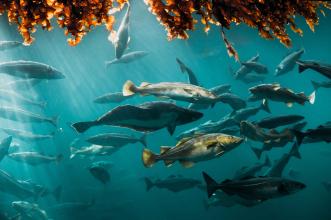
What are Microplastics?
Microplastics are little non-biodegradable plastic fragments found in our oceans, lakes, and various waterways, which may damage our environment and aquatic life (National Ocean Service, n.d.). In our oceans and Great Lakes, plastic is by far the most common sort of marine trash to be discovered. Plastic accumulation comes in various forms and sizes, but those that are smaller than five millimeters in length are referred to as "microplastics."
Where do they come from?
Plastic can be degradable, even traditional plastic, but just because it can be broken down into tiny fragments or powder does not mean the materials will ever return to nature. Plastic waste that degrades into smaller particles are one form of microplastic. Microbeads are another type of microplastic. They are tiny pieces of synthetic polyethylene plastic used as an additional exfoliant in personal care and cosmetic products. These small particles in the oceans can cause harm to aquatic life since they can readily pass through water purification systems (National Ocean Service, n.d.).

Is ingesting microplastics harmful?
Studies have identified microplastics in the faeces of persons from Europe, Russia and Japan. Numerous animal experiments have shown that microplastics can cross the intestinal barrier and enter the general circulation. The plastic particles may then spread throughout the body. In-vivo experiments have shown the presence of microplastics in rat's stomachs, intestines, kidneys, and hearts. Mice fetuses and fish brains have been shown to contain plastic particles of micron thickness. Based on these types of studies, microplastics have been linked to oxidative stress, DNA damage and inflammation, among other health issues. When inflammation persists and gets turned up too high, it is known as chronic inflammation. Research has shown that chronic inflammation is associated with a number of diseases including arthritis, heart disease, diabetes, cancer and bowel diseases like Crohn's disease and ulcerative colitis (Plastic Soap Foundation, 2021).
Harm to aquatic life
In the recent years we have seen a massive rise in scientific attention to this issue, which has resulted in overwhelming evidence of the detrimental impacts of microplastic contamination on marine life. In both freshwater and estuarine ecosystems, similar evidence has been observed. There are thus growing concerns about microplastics in aquatic systems as an emerging pollutant (de Souza Machado et al., 2018). For marine species, maybe the primary mode of harm is that organisms ingest non-nutritional plastic particles and do not consume enough food to live. A researcher has examined the intestines and tissues of deceased sea turtles recovered on beaches for plastics and toxins. Nine hatchling hawksbill turtles under the age of three weeks were studied by her team in 2020. A hatchling as small as 9-centimeters was found to have 42 particles of plastic in its digestive tract. It was mostly microplastics (Lim, 2021).

Harmful risks of microplastics to fish in the ocean
European Marine Strategy Framework Directive and US Microbead-Free Waters Act are praised for their lofty aims to safeguard the marine environment from microplastic contamination. Consequently, the issue of microplastic contamination in marine habitats and fish consumption is fast gaining attention. Microplastics in the fish gastrointestinal system are transient, with minimal accumulation potential in the gastrointestinal tract. Regardless, the overall load of microplastics that a fish will ingest in its lifetime is certainly substantial and will continue to rise. Ingestion of micro-and nano plastics has been shown to harm fish health. Ingestion of microplastics causes intestinal obstruction, physical damage, histological changes, behavioral changes, even changes to lipid metabolism (Jovanović, 2017). Last year, computer simulations used an approach to forecast how frequently fish will meet microplastics tiny enough to ingest and the chance of consuming enough specks to affect their development (Lim, 2021). According to the study, at the present pollution levels of microplastics, fish are at a danger in 1.5% of the places tested for microplastics. According to Dr. Koelmans, there are likely hotspots where the hazards are larger. It is doubtful that microplastics will spread elsewhere in the deep water, and there is no means to remove them once they are buried under silt (Lim, 2021).

No microplastics present in our products
We have tested our Extra Virgin Cod Liver Oil for microplastics with EuroFins. Eurofins is a respected world leader in bioanalytical testing with a global network of 250 laboratories across 40 countries. We tested for 8 Polymer Microplastics ranging in size from 27 μm (0.027 mm) to 5000 μm (5 mm). They included the following:
The great news is that the above microplastics were NOT detected in our fish oil samples. In partnership with the worldwide respected EuroFins, we are keeping our customers safe while delivering the most pure and raw products on the planet.
References
- Barboza, L. G. A., Lopes, C., Oliveira, P., Bessa, F., Otero, V., Henriques, B., ... & Guilhermino, L. (2020). Microplastics in wild fish from North East Atlantic Ocean and its potential for causing neurotoxic effects, lipid oxidative damage, and human health risks associated with ingestion exposure. Science of the total environment, 717, 134625.
- De Souza Machado, A. A., Kloas, W., Zarfl, C., Hempel, S., & Rillig, M. C. (2018). Microplastics as an emerging threat to terrestrial ecosystems. Global change biology, 24(4), 1405-1416.
- Jovanović, B. (2017). Ingestion of microplastics by fish and its potential consequences from a physical perspective. Integrated environmental assessment and management, 13(3), 510-515.
- Lim, X. (2021). Microplastics are everywhere—but are they harmful?. Nature. Retrieved from https://www.nature.com/articles/d41586-021-01143-3
- National Ocean Service. (n.d.). What are microplastics? NOAA. Retrieved December 16, 2021, from https://oceanservice.noaa.gov/facts/microplastics.html
- Plastic Soap Foundation. (2021, January 15). Health effects of Microplastics & Pathogens. Plastic Health Coalition. Retrieved December 16, 2021, from https://www.plastichealthcoalition.org/microplastics/?gclid=Cj0KCQiAweaNBhDEARIsAJ5hwbcUrrexuGZQnOiHF0iBhzIjSTghpnBsD0SQi8o-nMU7SjJc9_IZnwEaAv8nEALw_wcB











Leave a comment